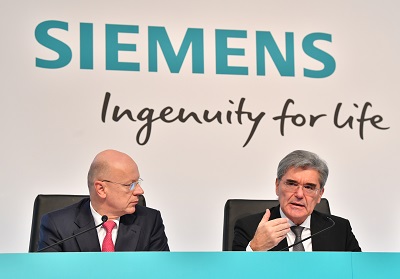Global energy powerhouse Siemens is to undergo a fundamental transformation by spinning off its gas and power divisions into a new entity which will also comprise its stake in windpower firm Siemens Gamesa.
Pending approval by an extraordinary shareholders’ meeting due for next month, the new company would list on the stock exchange by September. Siemens said it will “remain a strong anchor in the new company” with a stake of near – but less than – 50 per cent, which would allow the new entity to have “complete independence and entrepreneurial freedom”.
The company would have an anticipated value of $30bn and comprise conventional power generation, power transmission and related services, oil and gas, plus Siemens 59 per cent in Siemens Gamesa Renewable Energy.
The move is part of a corporate strategy called Vision 2020+ which is designed to refocus Siemens’ industrial vision on next-generation business arms – namely Digital Industries and Smart Infrastructure.
By spinning off the Gas and Power parts of the group, Siemens says it will save $2.4bn by 2023 – yet it also expects to add 10,000 jobs to the Digital Industries and Smart Infrastructure.
Announcing the company shake-up yesterday, Siemens president Joe Kaeser said the success of Siemens’ businesses of the next generation “will be determined by new factors: breadth, size and a ‘one size fits all’ approach will be replaced by focus, speed and adaptability”.
“That’s how we’ll ensure sustainable success of our businesses in the age of the digital Fourth Industrial Revolution, in which these new factors are a crucial to compete”.
He said the spin-off “will create a powerful pure play in the energy and electricity sector with a unique, integrated setup – an enterprise that encompasses the entire scope of the energy market like no other company”.
“Combining our portfolio for conventional power generation with power supply from renewable energiesvtbfywyatyfffacxfszqxxycwstdzutxuwaafw will enable us to fully meet customer demand. It will also allow us to provide an optimized and, when necessary, combined range of offerings from a single source. We’re convinced that this strategic decision will be positive for all participants and enable long-term value creation for customers, employees and shareholders – as can also be seen in recent market successes such as those in Iraq, which we’ll jointly continue to pursue.”
Chairman of the Siemens board Jim Hagemann Snabe said the move was “the right thing to do. It’s necessary and courageous to trigger the planned changes when the company is doing well.”
The restructuring will have an impact on staffing, but Birgit Steinborn, chairwoman of employee representative group, the Central Works Council of Siemens, said she would “reject unimaginative job-cutting programmes”.
“The employee representatives agree to the plan and support management’s growth strategy. If the board is serious about the growth concept, we expect employee expertise to be retained at the company and developed or expanded with respect to digitalization.”
The new Gas and Power company will be led by Lisa Davis as chief executive. She said yesterday that as global electrification “continues to be vital to economic and environmental progress around the world”, Siemens would now “have more freedom and agility to be able to concentrate fully on the highly-specific and quickly changing requirements of our markets and customers. In addition, we’ll be able to more directly control our costs and ensure that our stakeholders benefit directly from every euro we spend.”
Klaus Patzak, currently managing partner of the Siemens Portfolio Companies, has been appointed chief financial officer.
Siemens said yesterday that it foresees considerable growth for its Smart Infrastructure business, particularly in Asia. It intends to intensify its activities in areas such as e-mobility infrastructure, distributed energy, smart buildings and energy storage, which it expects to generate annual revenue growth of four to five per cent across the whole Smart Infrastructure portfolio.
Digital Industries chief executive Klaus Helmrich said the aim of the business was to “outpace overall market growth, even under more volatile market conditions”. He said a key focus would be “forward-looking technologies like edge and cloud computing, artificial intelligence and additive manufacturing”.




